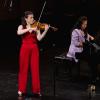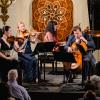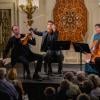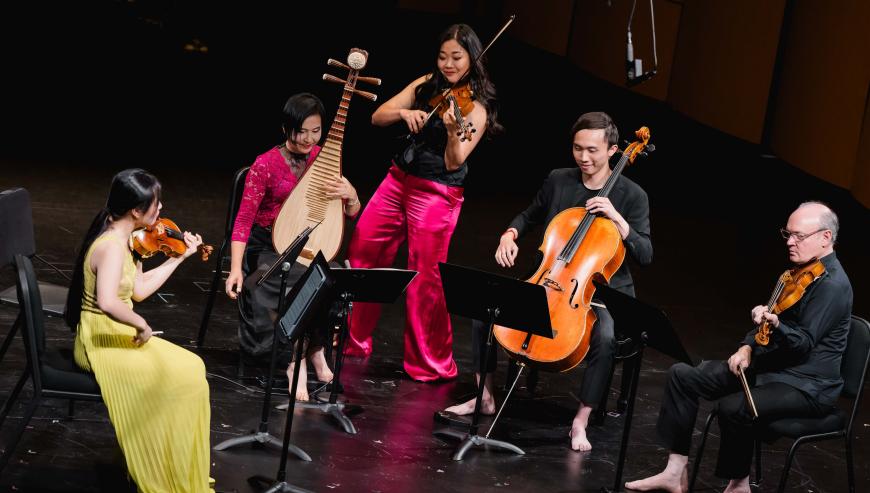
There might still be people around who’d react to a concert titled “Chamber Music Now” by screaming and running away. That didn’t happen at Music@Menlo’s closing event on Saturday, Aug. 5. The kind of composer who used to typify new music, who’d sneer, “Who cares if you listen?” at uncomprehending audiences of their formidably complex compositions, was not represented.
The two composers of newly commissioned pieces at Menlo spoke, at a “Cafe Conversation” on Friday, of the desire of today’s composers to communicate with audiences. David Serkin Ludwig said he thinks of himself as a storyteller, and you can’t tell a story without attentive listeners. Wang Jie was even more emphatic. To her, reaching inside the audience is the purpose of composing, and the music-making occurs more as the listeners feel the work than as the performers execute it.
The music at Saturday’s concert at the Spieker Center for the Arts, most of it less than 10 years old, only intermittently sought the traditional goals of beauty and profundity. These composers have different aims: to be as interesting as they can be and, when possible, to be fun. Some also provided a strong mix of theatricality, whether in outright drama or in visual effects that would be pointless on an audio recording. The result was more akin to the conceptual art at a Fluxus event from the early 1960s than to anything which would pass for conventional new music of the same era. Cheerful, even whimsical, experimental techniques took precedence, solid as the music itself often was.
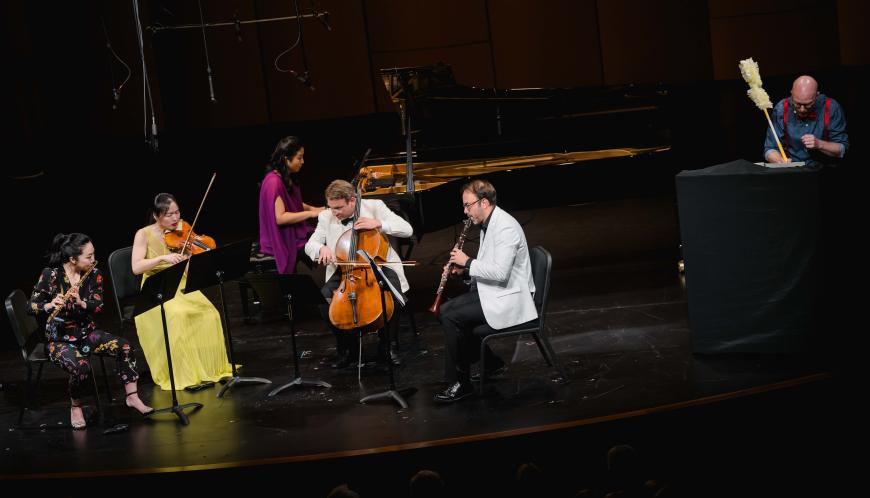
The most theatrical piece on the program was Wang’s Blame the Obituary, scored for narrator, flute, clarinet, violin, cello, and piano, the same ensemble for which Arnold Schoenberg wrote Pierrot lunaire. Wang’s compositional style, however, more resembles Igor Stravinsky’s L’Histoire du Soldat, though her work is considerably more succinct and the narration is fully integrated into the music. NPR broadcaster Fred Child acted the role of a failed movie screenwriter who’s composing his own obituary in advance so that it will say what he wants. He speaks normally, but the rhythm is notated precisely. Sometimes the mimicking of the rhythm of ordinary speech comes off stiffly.
But this is integrated into the music most ingeniously. Daniel, the screenwriter, talks to the music, and the music talks back to him. Cellist Dmitri Atapine and clarinetist Tommaso Lonquich stood up and posed musical phrases at Daniel in direct conversation. Because Daniel’s speech is musically notated, Wang says that in this work the words are music. Here, though, the music is also words. Wang has achieved the multivalent artistic communication she’s after.
Child also read the part of a tardigrade, a micro-animal that’s the protagonist of Daniel’s action-adventure movies. He used a nasal voice in a clipped, precise rhythm, so it was hard to make out what exactly the character was saying.
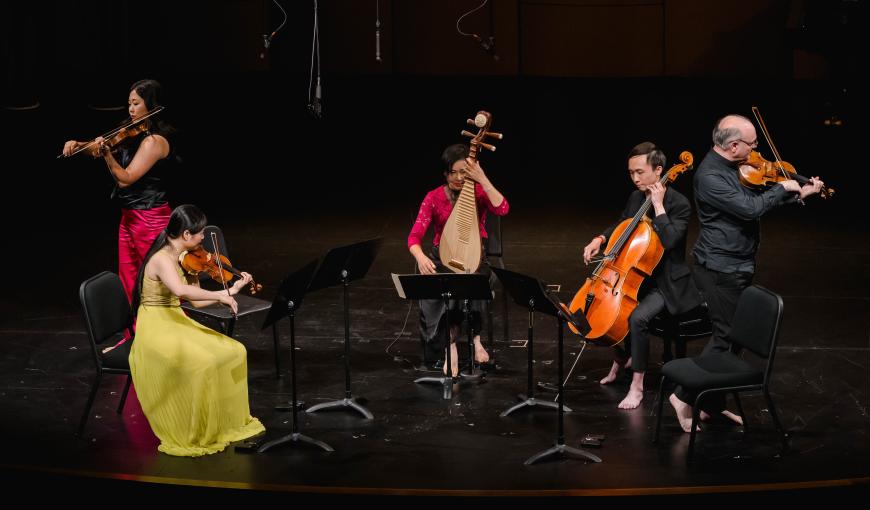
Tan Dun’s Concerto for String Quartet and Pipa, written in 1999 (a reworking of the composer’s Ghost Opera from 1994), also has theatrical content. The pipa, played here by virtuoso Min Xiao-Fen, is a Chinese plucked instrument resembling a European lute and usually played in tremolo, like a mandolin. The string quartet alternates between imitating the pipa with plucks and snaps and sounding as unlike it as possible: heavy thumps, deep grinding sounds, tuning up in the middle of the music. All the musicians were barefoot Saturday, the better to stomp their feet and for the quartet to stand up, still playing, and exit quietly at the end, in the manner of Haydn’s “Farewell” Symphony. At another point, second violinist Kristin Lee danced around each of her colleagues while playing wildly and then ran out of energy and sat down with a theatrical sigh. There are passages of soft beauty in this music, and the pipa is never harsh. This work is more than its theatrics.
On the other hand, Brett Dean’s Seven Signals (2019) for clarinet, violin, cello, and piano seems to be a summation of its gimmicks. Instruments play Morse code messages in monotone or in knocks on the side of the piano. They imitate day tallies scratched on a prison wall (heavy repeated notes) or a lighthouse beacon (brief squiggles of sound). The strings evoke semaphore by whisking their bows through the air. Violinist Arnaud Sussmann hit things with his bow, apparently accidentally, but in this work, who can tell? None of these evocations would be obvious if a listener didn’t keep track of the successive movement titles in the program book, but once decoded, they have the value of curiosities.
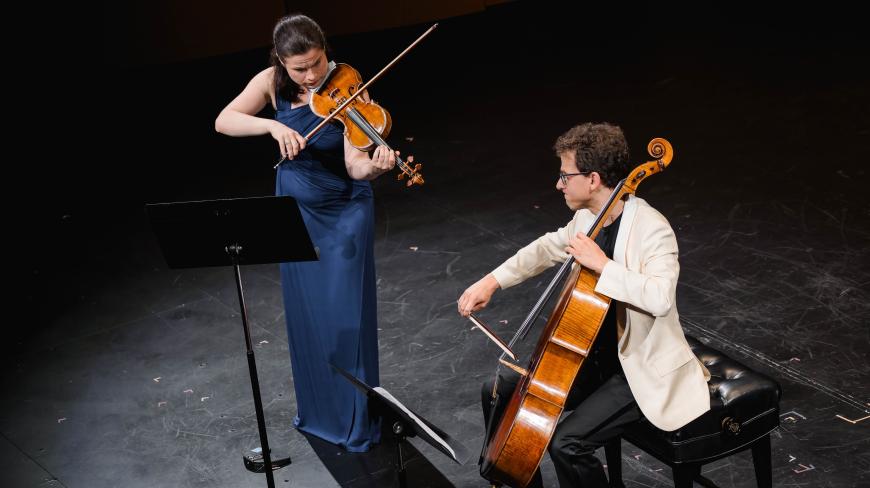
In this context, Jessie Montgomery’s Duo for Violin and Cello (2015) was a conventional work of witty experimentation. It’s full of all the imaginative things these two instruments can do ordinarily. Violinist Bella Hristova and cellist Nicholas Canellakis played together, then separately, imitating each other. One played a melody while the other offered pizzicato harmony, and then they exchanged roles. They did the same thing with a melody and a drone. There are churning arpeggios and growling sounds, and there are sliding glissandos on pizzicato notes for a country music touch. It’s all polite “Antics” and “Serious Fun,” in the words of two of the movement titles.
Ludwig’s Hashkiveinu for violin, cello, and piano was something of an outlier on this program. This piece, based on a Hebrew prayer of supplication said at bedtime, evokes fears and mourning and closes with calm hope. That gave it a welcome degree of seriousness unique to this concert. Even the chaotic passages had a slow dignity to them. Still, there were enough glissando slides, harsh spiccato notes, piano thumps, and gentle sawing arpeggios in the strings to evoke a kinship with the rest of the program.
The principal goal of these works, to catch listeners’ interest and even tickle their fancies, is a big change from the more daunting music of the last century. It’s a goal this concert achieved with brisk dispatch. Everyone seemed to come away happy.


